Diapering
Ok, enough with the pleasantries. Let’s get down to brass tacks.
You will be changing your newborn’s diaper roughly 5-8 times per day, and about 5-6 times a day for a 6-month-old. Your baby will be wearing diapers morning, afternoon, and night for the next 1-3+ years (about 5,000 in total), so it’s important to find a solution that works for you.
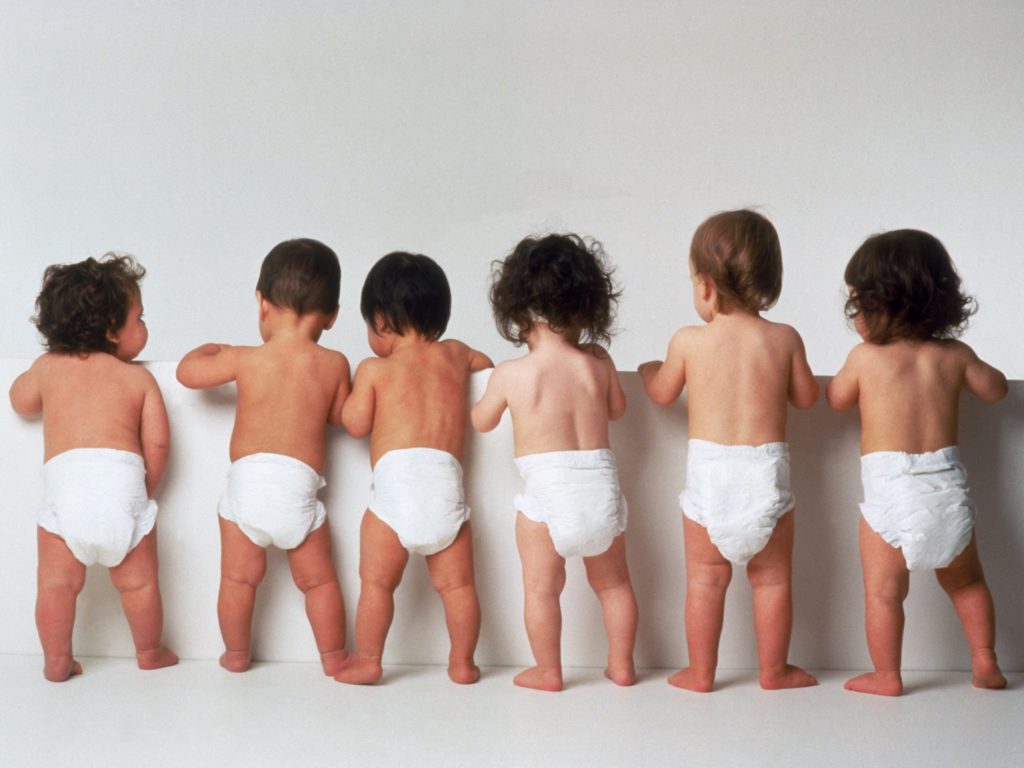
Unlike our parents’ generation (who trudged barefoot through the snow and used animal pelts for diapers), there are now many options available for diapering your baby: cloth diapers, disposable diapers, and diaper services. There are even some combinations thereof.
Diapering Considerations
There are a few considerations to take into account when deciding which diapers to use, such as…
- Your gusto — If you aren’t using disposable diapers, there’s more work required, so ask yourself where you stand on the lazy/gung ho continuum. And keep in mind that it’s not just you, but anyone who will be changing your baby’s diapers: your partner, grandparents, and nannies/caretakers. Some daycares, for example, will only use disposables.
- Cost — A quick calculation: unless you are using a clean-at-home cloth diaper system, you will be spending *roughly* $40/month on diapers. Some diapers are cheaper, like store brands. Some are more expensive. You may decide, after getting pooped on multiple times, that a higher quality diaper is worth the extra money. Or maybe you’re into it (hard for me to say, we just met). According to Consumer Reports, the average family spends about $2,500 on diapers per child. If you opt for eco-friendly (more pricey) diapers – good for you, btw – that number is even higher: $3,500.
- The eco-factor — The sad truth is that 3.5 million tons of diapers end up in landfills every year. While cloth diapers don’t end up in the landfill, they do require lots of water and power to launder. Some say the carbon footprint of cloth and other eco diapers may not be that much less, in reality. (You can reduce the carbon footprint of cloth diapers by washing them in cold water and hanging them to dry.) What about disposable diapers? We recommend fragrance-free diapers, as toxic chemicals can be lumped in with a “fragrance” so they don’t have to be disclosed on the list of ingredients (due to “trade secret” laws). We also prefer chlorine-free diapers if they’re available to you.
- Skin sensitivity — If your baby has sensitive skin, you may want to opt for Pampers Sensitive or cloth diapers.
- Boy or girl — Boys tend to pee more in the front of their diaper, and for girls, pee tends to collect in the middle and back. Boys often have leaky pee pee diapers because their little weenies point in a certain direction and they pee with direction and… force (ever seen a girl write her name in the snow? Didn’t think so). For boys, getting a snug fit around the thighs matters a lot.
These days, upwards of 90% of parents still use disposable diapers. The reason is… because they are so very convenient.
Look, every time I throw a diaper in the trash can, I feel bad, okay? I am otherwise a very good citizen of the earth: I recycle and compost, I take mass transit every day instead of driving, I [used to] make baby food instead of buying it in the jar… but when it came to scooping poop from a diaper into the toilet, then washing a bunch of poop-stained diapers in the washing machine (for which I had to use COINS because we rented an apartment in the city), my head started to explode. I’m sorry, Mother Earth. I hope you’ll find it in your earthy heart to forgive me. I still love you.
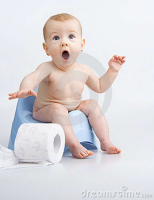
As a practical matter, if you really want to reduce your baby’s carbon footprint, the best way to do it is by potty training early. For example, if you train at two years instead of three, you are saving a YEAR’S worth of diapers! That’s great both for Mother Earth and for your pocketbook.
Many moms and nannies are now teaching their babies “elimination communication” (“EC”). EC has been practiced in Asia and other parts of the world for centuries and is making a comeback in America. Read here about EC, or the “diaper-free baby movement.”
Disposable Diapers
1. Pampers: Swaddlers/Baby Dry/Pure Protection ~ 28-33 cents ea
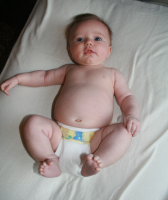
In the hospital, Pampers Swaddlers will (probably) be the first diaper to hit your baby’s bottom. I am very happy with the performance of Pampers; they are soft, fit well, and contain leaks. Pampers Swaddlers are incredibly soft and have an umbilical cord notch for newbies. They also have a line that changes color to indicate wetness.
Pampers Baby Dry diapers are extra absorbent, thus especially good for overnight use (with three layers instead of two) and contract with baby’s tummy as the night goes on to ensure a snug fit.
Now, they have a new line called Pampers Pure Protection, their (somewhat) eco-friendly brand, which is their answer to Hello Bello and Honest Co. These will run you a little more (roughly $.37 ea). For more comparison, see Hello Bello Diaper Review.
Lastly, Pampers Cruisers are designed to be less bulky for active, older babies and start at size 3. On the downside, Pampers are not chlorine-free or otherwise eco-friendly. You can get similar performance with our favorite diaper, Earth’s best Tender Care (#5, below).
2. Huggies: Little Snugglers/Snug & Dry/Special Delivery ~ 27-37 cents ea
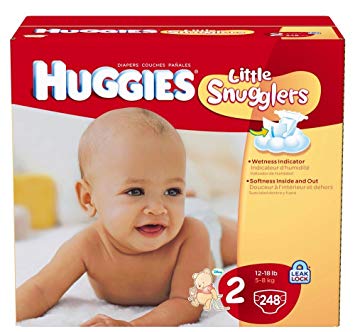
Made by Kimberly-Clark, Huggies competes for the same high-end brand name market as Pampers. This diaper is not my favorite, but many seem to like it. Like Pampers, these diapers contain chlorine. Huggies also contain latex and fragrances.
Huggies makes Little Snugglers for newborns, which are very similar to Swaddlers. Huggies Snug & Dry has an elastic waistband for a tighter fit. Little Movers are size 3+ for bigger, more active babes. Bottom line: I think you can do better.
3. Bambo Nature ~ 43 cents ea – Top Eco Pick
A new-ish diaper on the scene, Bambo Nature is a legit eco-diaper that performs very well. Just a warning, they are quite pricey!
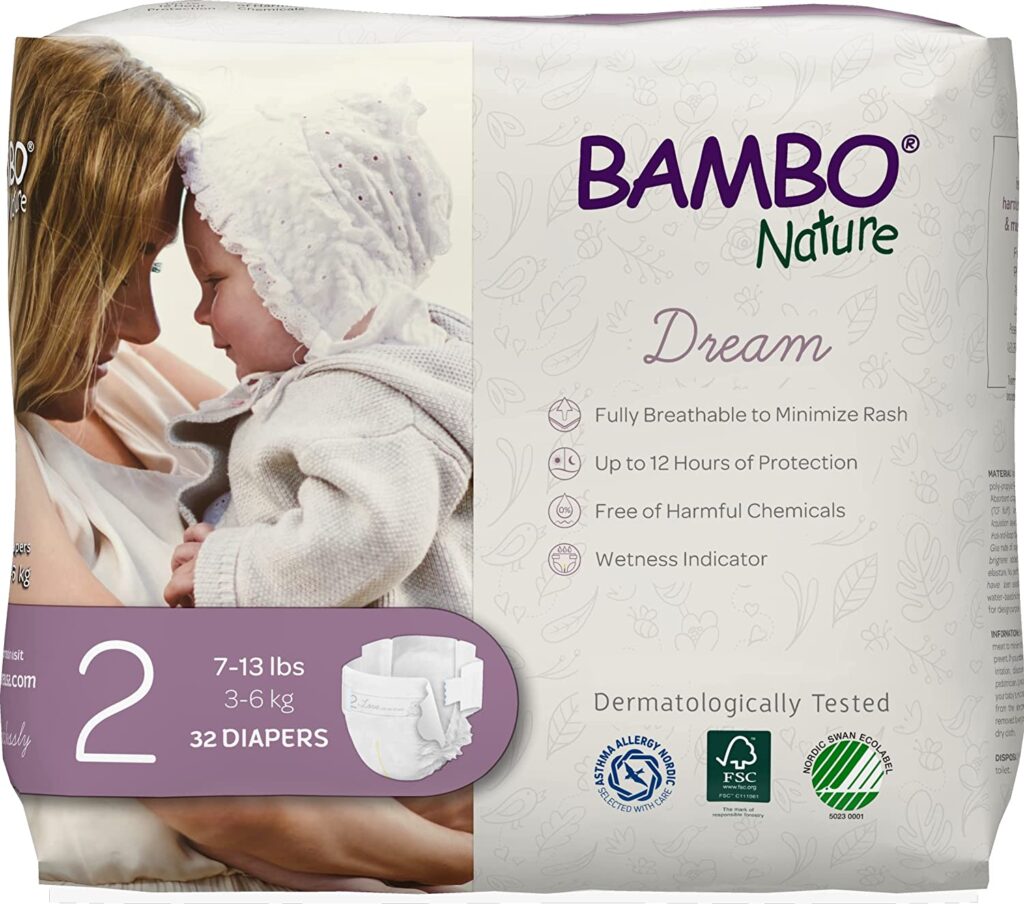
4. Luvs ~ 16 cents ea
Luvs makes a much cheaper diaper and you get what you pay for. It’s a decent diaper, although not very well made. Coincidentally, Luvs and Pampers are both made by Procter & Gamble, Pampers being the premium brand and Luvs being the economy brand. If you’re on a tight budget, I would instead recommend a chlorine-free store brand, such as Target’s up & up, which runs about 13 cents per diaper and performs relatively well.
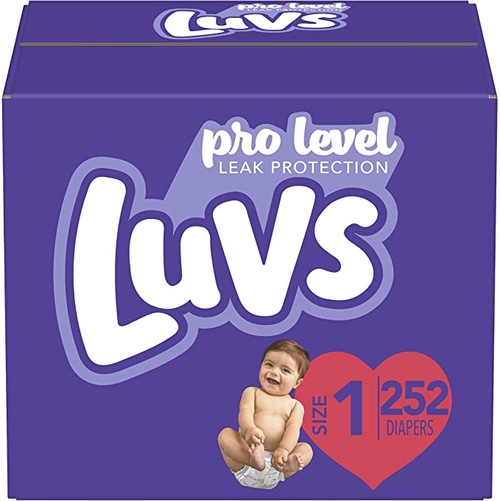
5. Earth’s Best TenderCare ~ $1.06 ea – Best All Around/Eco
These are my favorite diapers and a favorite among eco-moms. They are hypoallergenic, chlorine-free, affordable, and perform exceptionally well. IMO, these diapers are the best combo of eco-friendly and absorbent. All of that, and they cost about the same as Pampers or Huggies. Some users say they run smaller than these mainstream brands, just FYI.
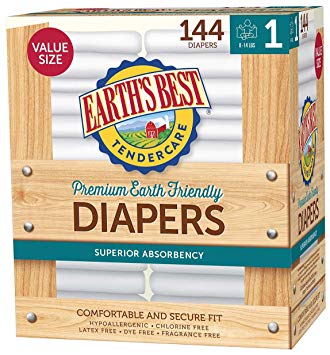
Green Diapers?
There are several other “green” diaper companies now, including the Honest Company, Hello Bello, Seventh Generation, and Parasol, but we’re still partial to Earth’s Best — not just for the price, but also for the quality.
Yes, Honest Company (and others) get a lot of publicity for their celebrity founders and Kardashian product placement, but generally, we are not impressed (to say the least, I’m being kind). They may be super cute, but parents frequently complain that diapers from the Honest Company, Hello Bello and Parasol really don’t contain the elements, so to speak… which is the whole point. (Seriously, they have horror stories. And if you end up having to use twice as many diapers to prevent leakage, how much greener can they really be? Plus, who wants to be changing twice as many diapers?)
→ Check out our review of Hello Bello Diapers.
Anyway, if you’re looking for a wallet-friendly, green disposable that performs, we think Earth’s Best is a better pick.
The bottom line: you may want to try a few different brands before deciding on one that fits your baby [and your budget] the best. See if you can borrow a few from a friend or just buy the smallest quantity possible, then buy in bulk once you’ve settled on a brand.
Also… Store Brand Diapers
There are more to choose from than just name brands. Yes, almost all of the big box stores offer their own store brand diaper.
According to independent tests, a great performer is up & up by Target, a decent chlorine-free diaper for a great price (~13 cents each). They also have an overnight version starting in size 3 which performs well.
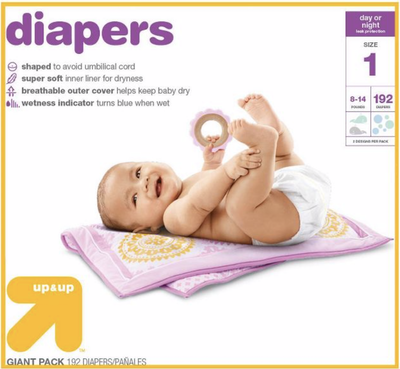
Parent’s Choice by Walmart is rated one of the worst, while Costco’s Kirkland diaper is lauded for being affordable, chlorine, perfume & latex free, but not the most absorbent.
Store brand diapers are considerably cheaper than name brands, so if money is tight, give them a shot. Speaking of which…
Is Money Tight?
For those on a tight budget, I highly recommend cloth diapers. Yes, I totally get that many people don’t have the time, energy, and laundry facilities to deal with cloth diapering, but if you do, cloth diapering will save you LOTS of money over the lifetime of the diaper years, especially if you have more than one kiddo using them.
Yes, cloth diapers are a more substantial up-front cost, but once you own them… they’re yours. Plus, you can often find them used or discounted with a little effort – check out Craigslist or your local children’s consignment store. For more on cloth diapers, keep reading…
From Whence Do They Come?
To save money, disposable diapers are best bought in bulk. For me, buying online is a worthwhile endeavor. I certainly don’t want to schlep huge boxes of diapers all around town.
Amazon used to have a program called Amazon Family, which gave you 20% off diapers and supplies with a subscription. This has since been replaced by the Subscribe and Save program, which gives you up to 15% off if you subscribe to receive a regular shipment of 5 or more items at a time.
Hello Bello Diapers also has a subscription that our readers like.
Disposable Diaper Sizing
For your newborn, you will start with a special size called Newborn, ‘N’ (there is no number). If you have a really small baby (less than 7 lbs), you may even start with size ‘P’ (Preemie). Don’t buy too many of these (P or N) because they will graduate to a size 1 in about two weeks!
From there, it goes from size 1-6, although you probably won’t make it past size 4 or 5 unless you wait a long while to potty train or if baby’s got back. Or both.
Notes:
- When buying diapers in the first three months or so, don’t go toooooo crazy with buying in bulk. Your baby is growing exponentially during this time. If you buy two huge boxes of size 1’s, for example, you may end up giving half of them away (I did).
- When traveling with your baby, don’t schlep large quantities of diapers with you. Just buy them when you get there or order them online to be delivered to your destination.
Disposable Wipes
For all of the number twos in your baby’s future, you will need wipes. And LOTS of ’em. Don’t put a whole lot of thought into this; they are all pretty much the same (except for Huggies: hate ’em). Unlike diapers, stock up on wipes; you will need them for years to come.
Diaper Changing Kits
For changing diapers on the go, I highly, highly recommend a changing kit. You can get away with not even having a diaper bag as long as you have one of these. With its portable wipe container and comfy pad, this is truly one of the most useful baby items. Ever.
I like the Skip Hop Changing Station ($29), and Munchkin also makes a nice one for about $15.
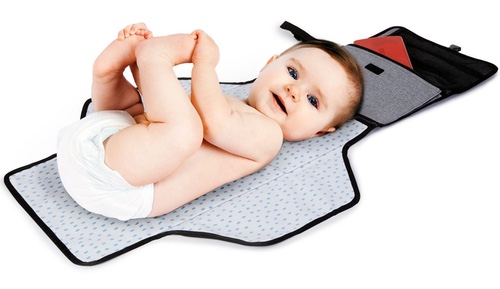

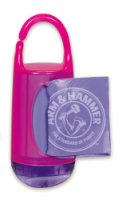
Diaper Sacks
For tossing stinky diapers on the go (especially while traveling!), get yourself a few rolls of disposable diaper sacks. We like Sassy ($10 for 200 bags) and Munchkin (Arm & Hammer, $4 for 24 bags and a dispenser). Doggie poop bags work fine too. Keep them in your diaper bag for good measure.
Cloth Diapering Overview
Cloth diapers have come a long way since the pre-folds and diaper pins our mothers used (but you can still use those, too, if that’s your thing). Cloth diapering is a great, money-saving, eco-friendly way to diaper your babe, not to mention SO CUTE!
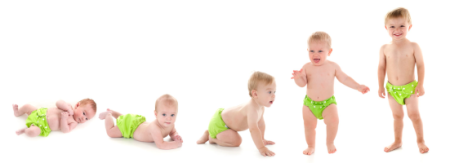
The world of cloth diapers is shockingly vast, with a whole new set of acronyms to learn. Our full cloth diaper content is coming soon. Until then check out the video content we produced with Mat York (That Dad Mat) ~
Cloth Diapering 101, Part 1: What’s it all about?
Cloth Diapering 101, Part 2: Favorite Brands — okay folks, this one is a little dated, it was shot in 2016. Needless to say, many of the brands have changed…. but it’s still good info.
Diaper Services
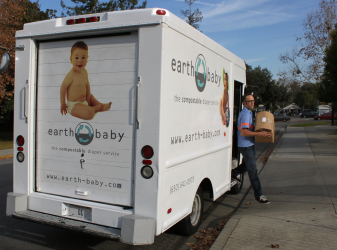
Too much work for you? Shoot, I’m breaking a sweat just thinking about all this washing and re-using.
If cloth diapers appeal to you but you can’t commit to all the obligatory work involved, you could consider a local diaper service. These organizations will deliver cloth or compostable diapers (depending on the service) to your house every week and pick up the old ones. No fuss, no muss (what is muss anyway?).
Embracing Change
Now that we have dipes and wipes covered, let’s talk equipment. Yes, you can change a diaper just about anywhere. But you will be doing it so often, why not make it comfortable?
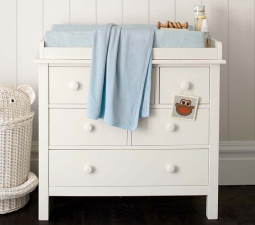
You need a good, sturdy surface on which to change your poopy princess (or prince). Ideally, you want it to be about waist-high or slightly higher. Anything lower and you’ll be straining your back. Trust me, diaper changing on a too-low surface is NOT fun.
The best approach, in my opinion, is to use the top of a dresser, which is already the right height (above). You can also buy a changing table made specifically for this, but when you no longer need it… it’s just an extra piece of junk, whereas a dresser you will use forever.
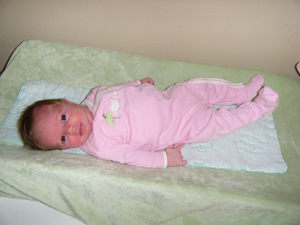
The most affordable solution is a soft changing pad, like the Summer Infant Contoured Pad (pictured left, $24). The changing pad is shaped like a half-pipe so your baby stays in place during a diaper change.
You’ll also need 2 or 3 changing pad covers (roughly $10 a piece). They get soiled pretty quickly so you’ll need more than one. On top of the changing pad cover, you will also need a whole bunch of waterproof pads (the white pad) as an added layer of protection — these are much easier to wash than the covers, and run $13 for a 3 pack. Get a whole bunch; you’ll be washing them all the time.
For a little more, check out the highly-rated PooPoose changing pad ($60), which has a superior security band to keep baby from squirming off the table and falling (yes, it happens!). This is the #1 rated changing pad on Amazon and for good reason.
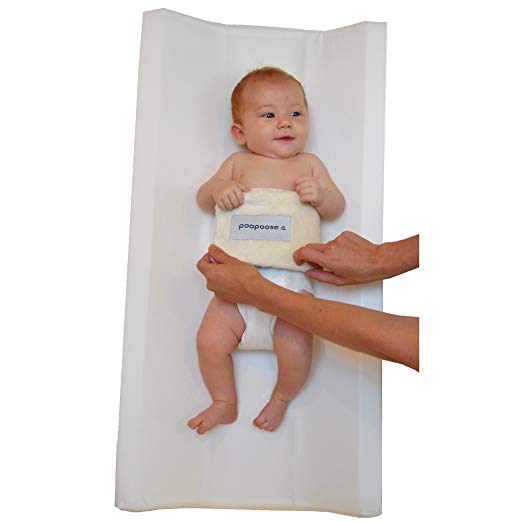

If you prefer something you can wash off directly, try the impermeable Keekaroo Peanut ($219, below). Riding the bandwagon, Bumbo and Skip Hop also make one for about half the price each.
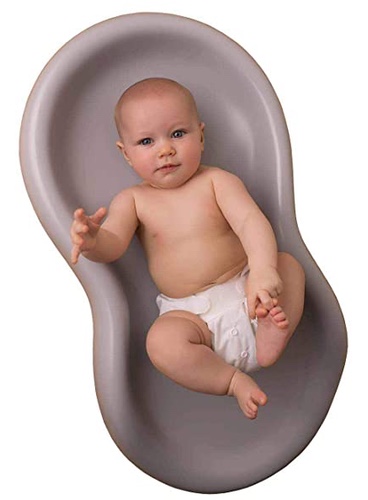

Heck, if you’re spending that much, and you’re in the market for something with a few more bells and whistles, I also like the Hatch Baby Grow ($149), an integrated baby scale and changing pad in one. The scale allows you to track weight gain, milk intake and other such things that are typically only ascertained by a visit to a pediatrician’s office. I would especially recommend this for parents who are the “need to know” type (those who like to have lots of data) or if you have any reason to expect a preemie (you are pregnant with multiples, high risk, etc.).
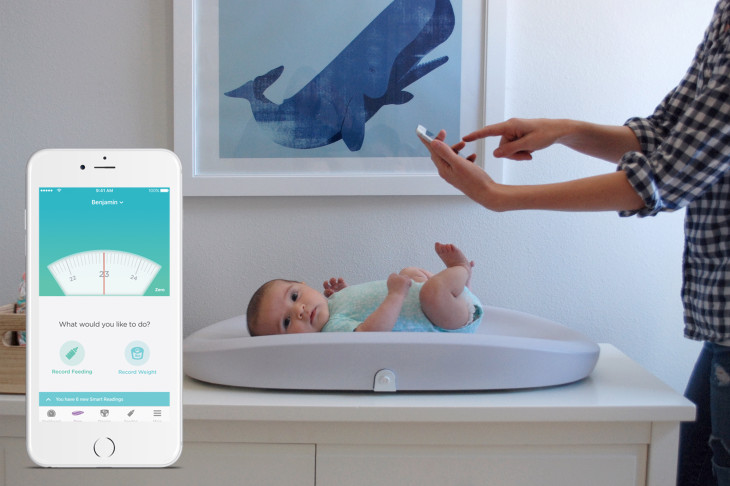

Diaper Pails
You’ll probably want a special trash can for disposing of diapers. Moms seem to be really divided on this topic. Some say: yes, the right diaper pail will conceal the poopy smell. Others say there is no way to *really* hide the smell of poo. I fall into the latter category.
My method: For the first 6 months (while on the breastmilk/formula-only diet), you can put poopy diapers in your diaper pail without creating a gross smell. But after your kiddo starts real food? Forget it, all bets are off. Out of the 5 or 6 diapers you change per day, about 1 or 2 of them will be poopy.
I like to use my diaper pail for pee diapers only. For the poopy diapers, buy rolls of Arm and Hammer diaper disposal bags (mentioned above). Put your poopy diapers in the little bag and simply throw it out every night (outside, like in the big garbage can). Is it a pain? Yeah, sort of, but it’s the only real way to keep your nursery from smelling like, well, shit. Or you can just put the poop diapers in there and deal with the smell. Your choice.
Meg Collins
If your goal is to get a trash can to conceal the smell, there are three that parents favor:
Dekor Plus Hands Free Diaper Pail ~ $49
An inexpensive hands-free pail that converts to a trash can when done with diapers. No need to squish diapers through a small hole (like the diaper genie, yuck!), simply step on the foot pedal, drop the diaper in the opening – and done!
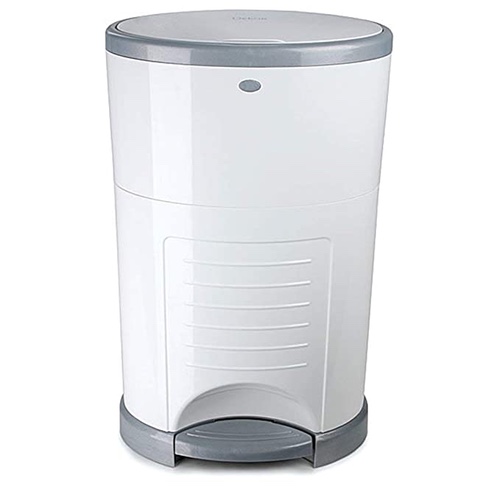
Munchkin Step Diaper Pail ~ $56
Another favorite which wins the odor control contest. This pail requires special bags and uses a baking soda dispenser (which you also have to refill) to control odor. It does require a bit of diaper-squishing, but not nearly as much as the Diaper Genie. If odor control is a top priority and you don’t mind buying special bags, this is your go-to.
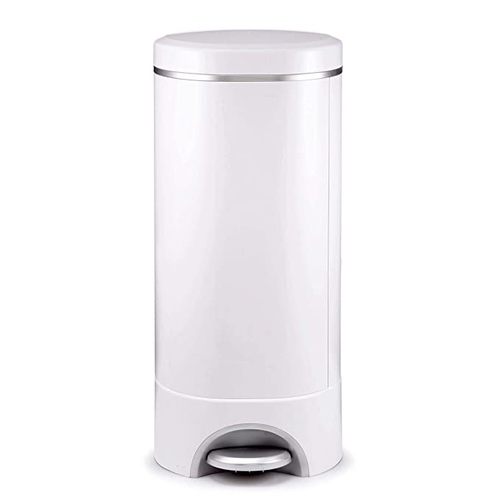
Ubbi Steel Diaper Pail ~ $75
For the design-conscious, an awesome yet pricier diaper pail is the Ubbi Steel Diaper Pail. At $79, this sleek diaper pail comes in dozens of different colors, is made of odor-blocking steel, AND doesn’t require special bags– it’s the top selling diaper pail on Amazon. If you have the money, the Ubbi is as good as it gets. And really? This is a worthwhile place to spend a little extra. If you have more than one kid, you could be using this for years.
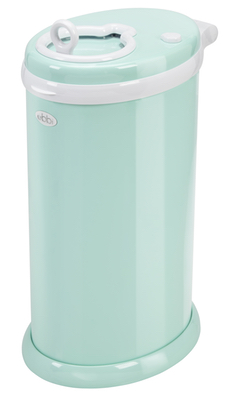
Best Diaper Rash Creams
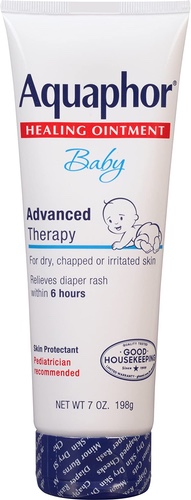
You don’t need to use any lotions or cream on your baby unless prescribed (much to the chagrin of your mother) — the only exception is diaper rash cream.
In the early days before the “real” poop starts (pre-solid foods), your baby will (hopefully) be a stranger to diaper rash, but keep some on hand just in case because you’ll need it eventually.
My favorites are Boudreaux’s Butt Paste (yes that’s really the name, which is why I bought it), Aquaphor and Desitin, although my pediatrician friends tell me that A+D is the best for prevention and Triple Paste is the best for treatment.
When your child inevitably gets his first stomach virus (and thus, terrible diarrhea), you will need boat loads of diaper rash cream. Just a heads up.
You’re more than halfway indoctrinated!
Next up is 7. Baby Feeding Essentials. Let’s go!